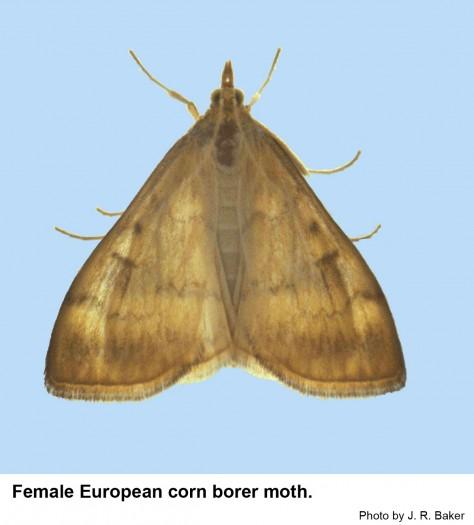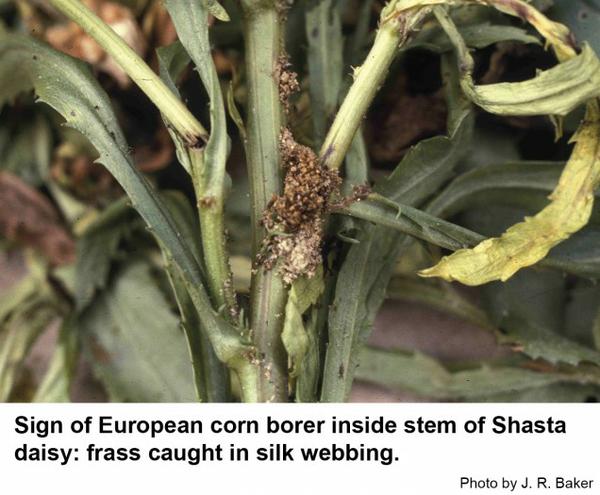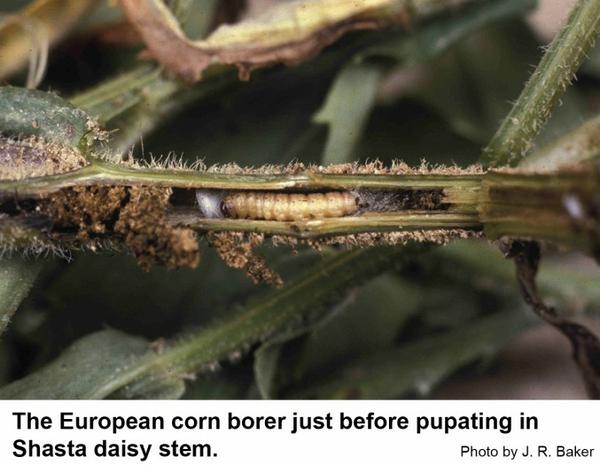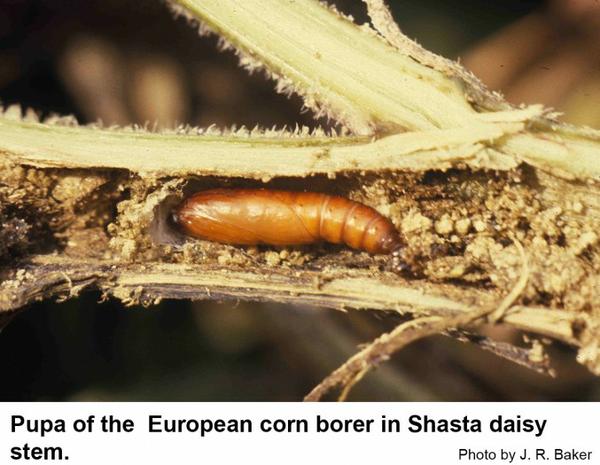Description and Biology
The European corn borer adult, Ostrinia nubilalis, is a yellowish brown snout moth that first appears in late spring. Females lay up to 600 eggs in flat masses of 15 to 20 on the underside of host plant leaves. The eggs resemble tiny fish scales in shape and arrangement. The worms hatch and feed on the surface of leaves for a few days. As the borers mature, they bore into the host plant stalk to feed and they eventually pupate inside. Newly hatched larvae are tiny and pale (about 1/16 inch long). Older caterpillars have black heads, five pairs of prolegs, and pale-yellow bodies bearing several rows of small black or brown spots. They develop through five or six instars to become a fully grown larva about an inch long. The brown pupa is about half an inch long with a smooth capsule like body. European corn borer caterpillars are cannibalistic (This explains why only one or two borers are found in a pot of mums even though the moth laid dozens of eggs.). We have four generations per year in North Carolina.
Host Plants
Although best known as a pest of corn, this worm has been found boring into more than 200 different plants including chrysanthemums, asters, cosmos, dahlia, gladioli, hollyhocks, roses, zinnia and some vegetables as well as corn. barley, beans, millet, oats, and sorghum. Frass and silk collect near the entrance hole. Eventually slender stalks lodge.
Residential Recommendation
The best pesticide recommendation we can give is to spray with a pyrethroid such as permethrin or bifenthrin every month or so as field crops harden off in mid to late summer. After the borers are in the stalk it is essentially too late to control them other than cutting out and destroying infested stems. This pest overwinters in the stalk, so destroying the stalks of corn, dahlia, mums and weeds in the area should help to suppress next season's population.
References
- Common name: European corn borer, scientific name: Ostrinia nubilalis (Hübner) (Insecta: Lepidoptera: Pyralidae). Capinera, J. L. 2000. Featured Creatures, Entomol.& Nematol. FDACS/DPI, Univ. Florida.
- Insect and related Pests of Flowers and Foliage Plants. Baker, J. R., ed. 1994. North Carolina Cooperative Extension Service Publication AG-136. 106 pp.
- Insect and related Pests of Vegetables. Sorensen, K. A. and J. R. Baker, editors. 1994. North Carolina Cooperative Extension Service Publication AG-295. 180 pp.
- Extension Plant Pathology Publications and Factsheets
- Horticultural Science Publications
- North Carolina Agricultural Chemicals Manual
For assistance with a specific problem, contact your local N.C. Cooperative Extension Center.
This Factsheet has not been peer reviewed.
Publication date: June 27, 2013
Revised: April 19, 2023
Recommendations for the use of agricultural chemicals are included in this publication as a convenience to the reader. The use of brand names and any mention or listing of commercial products or services in this publication does not imply endorsement by NC State University or N.C. A&T State University nor discrimination against similar products or services not mentioned. Individuals who use agricultural chemicals are responsible for ensuring that the intended use complies with current regulations and conforms to the product label. Be sure to obtain current information about usage regulations and examine a current product label before applying any chemical. For assistance, contact your local N.C. Cooperative Extension county center.
N.C. Cooperative Extension prohibits discrimination and harassment regardless of age, color, disability, family and marital status, gender identity, national origin, political beliefs, race, religion, sex (including pregnancy), sexual orientation and veteran status.







